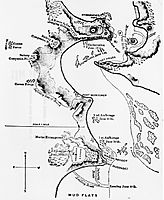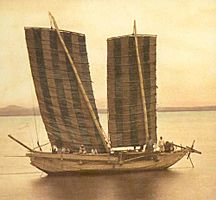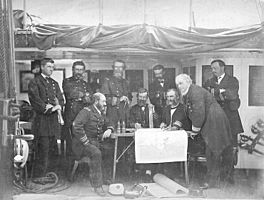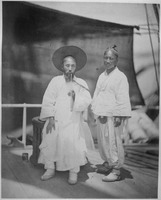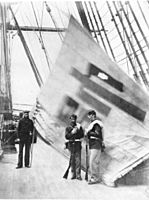United States expedition to Korea facts for kids
Quick facts for kids Korean Expedition |
|||||||
|---|---|---|---|---|---|---|---|
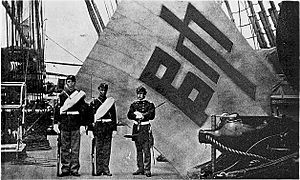 The captured Sujagi aboard USS Colorado in June 1871 |
|||||||
|
|||||||
| Belligerents | |||||||
| Joseon | |||||||
| Commanders and leaders | |||||||
|
|||||||
| Strength | |||||||
|
|
||||||
| Casualties and losses | |||||||
|
|
||||||
| United States expedition to Korea | |
| Hangul |
신미양요
|
|---|---|
| Hanja |
辛未洋擾
|
| Revised Romanization | Shinmiyangyo |
| McCune–Reischauer | Shinmiyangyo |
The United States expedition to Korea was the first time American forces took military action in Korea. It happened mostly on and around Ganghwa Island in 1871. In Korea, this event is known as the Shinmiyangyo (Korean: 신미양요; Hanja: 辛未洋擾; lit. "Western Disturbance in the Shinmi Year (1871)").
The main goal of the American forces was to find out what happened to the merchant ship General Sherman. This ship had gone missing in 1866 while visiting Korea. The Americans also wanted to discuss trade and political relations with Korea.
However, the American ambassador, Frederick Low, also wanted to show American power. The American commanders believed they had the right to enter Korean waters. They used heavily armed warships and ignored Korea's requests to respect their borders.
In 1871, the U.S. sent Ambassador Low and the U.S. Navy's Asiatic Squadron to Korea. They wanted to investigate the General Sherman and open trade. But Korean officials clearly told Low they were not interested in a trade agreement.
On June 1, Korean shore batteries attacked two American warships. These ships were sailing down the Han River. Low decided to attack the forts unless Korea apologized. However, Korean officials said the Americans were wrong for sending warships into their waters. They also explained what had happened to the General Sherman.
The governor of Ganghwa sent some gifts to try and calm things down. But the Americans refused the gifts and launched an attack. The Korean government wanted to stay isolated from other countries. The Americans did not respect Korea's rules. This led to a diplomatic visit turning into a fight.
On June 10, about 650 Americans landed and captured several forts. This led to the Battle of Ganghwa. Over 200 Korean soldiers were killed, while only three American soldiers died. Low thought the Koreans would give up after this. But Korea refused to negotiate further.
Low then realized his forces were not strong enough to reach their goals. He also heard that Korea was sending many more soldiers. So, he decided to pull back his troops. A trade treaty between the two countries would not happen until 1882. This was six years after Japan forced Korea to end its isolation in 1876.
Contents
First Contact with Korea
The American expedition had about 650 men. More than 500 were sailors and 100 were Marines. They had five warships: Colorado, Alaska, Palos, Monocacy, and Benicia. Rear Admiral John Rodgers and Ambassador Frederick F. Low were on the Colorado. The Korean forces, called "Tiger Hunters," were led by General Eo Jae-yeon.
The Americans first met Korean people, who were described as "people wearing white clothes". When asked about the General Sherman incident, the Koreans did not want to talk about it. They likely wanted to avoid paying for any damage. The Americans then said their fleet would explore the area and meant no harm.
However, this was a misunderstanding. At that time, Korean rules did not allow foreign ships on the Han River. This river led directly to the capital city, Hanyang (modern-day Seoul). So, the Joseon government said no to the U.S. request. But the United States ships sailed anyway.
On June 1, a Korean fortress fired at the U.S. fleet. The ships were sailing up the Ganghwa Straits, which leads to the river. The U.S. forces were not badly hurt. This was because the Korean cannons were not aimed well. Their firing was "very hot for the fifteen minutes," but it did not cause much damage. The U.S. demanded an apology within 10 days. When there was no answer, Admiral Rodgers decided to attack the forts.
The Battle of Ganghwa
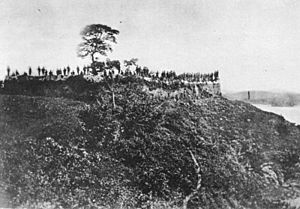
On June 10, the Americans attacked the Choji Garrison on Ganghwa. This fort was not well defended. The Koreans had very old weapons, like matchlock muskets and cannons. The Americans quickly took over the fort. Then, they moved to their next target, the Deokjin Garrison. The Korean soldiers there were not well armed. American 12-pound howitzers kept them from getting close enough to fight effectively.
The American troops continued to Gwangseong Garrison, which was a strong fortress. By this time, Korean forces had gathered there. Along the way, some Korean units tried to attack the U.S. forces from the side. But they were defeated again. This was because the Americans had placed their artillery well on two hills.
Artillery fire from the ground troops and the Monocacy ship hit the fortress. This prepared it for an attack by U.S. forces. A group of 546 sailors and 105 Marines gathered on the hills. They fired at the fortress and also protected the American sides and back. Once the bombing stopped, the Americans charged the fortress. Lieutenant Hugh McKee led the charge.
The Korean matchlock guns took a long time to reload. This helped the Americans, who had better Remington rolling block carbines. The Americans were able to get over the walls. The Koreans even started throwing rocks at the attackers.
McKee was the first to enter the fortress. He was badly wounded and died. Commander Winfield Scott Schley then shot the Korean soldier who had killed McKee. The flag of the Korean commander, General Eo Jae-yŏn, was captured. This flag was called the "Sujagi" by Koreans. Corporal Charles Brown and Private Hugh Purvis captured it. General Eo was killed by Private James Dougherty.
While carrying the flag for the Colorado crew, Colorado Carpenter Cyrus Hayden put the U.S. flag on the walls. He did this while under heavy enemy fire. Corporal Brown, Privates Dougherty, Purvis, and Carpenter Hayden all received the Medal of Honor.
The battle lasted only fifteen minutes. A total of 243 Koreans were killed, and three Americans died. These Americans were McKee, Seaman Seth Allen, and Marine Private Denis Hanrahan. Ten Americans were wounded. Twenty Koreans were captured, and some of them were wounded. Five Korean forts were taken, along with many small cannons.
The Korean deputy commander was among those captured. The U.S. hoped to use the captives to meet with Korean officials. But the Koreans refused. They called the captives cowards and said the Americans could keep them. The Americans later released the prisoners.
After the fighting from June 10–12, the United States Asiatic Squadron stayed near Jakyak Island. They left for China on July 3.
What Happened Next
The United States hoped their victory would make the Koreans willing to talk. But the Koreans refused to negotiate. In fact, these events made the regent Daewon-gun even stronger in his policy of isolation. He issued a national statement against being friendly with foreigners.
Also, the Koreans quickly sent many more soldiers. These new troops had modern weapons to fight the Americans. Realizing the situation had changed, the U.S. fleet left and sailed for China on July 3.
There were no more attacks on foreign ships after this. In 1876, Korea made a trade treaty with Japan. This happened after Japanese ships came to Ganghwa Island and threatened to fire on Seoul. Treaties with European countries and the U.S. followed soon after.
Many American sailors and Marines received the Medal of Honor for their bravery. These included nine sailors and six Marines. This was the first time the Medal of Honor was given for actions in a foreign conflict.
Treaty of Amity and Commerce
From April to May 1882, the United States and Korea created a 14-article treaty. Commodore Robert W. Shufeldt represented the U.S. Navy. This treaty created friendship and promised help if either country was attacked. It also covered specific things like rights for American citizens in Korea. It also gave the U.S. "most favored nation" trade status. This meant the U.S. would get the best trade deals Korea offered to any other country.
This treaty stayed in effect until Korea was taken over by Japan in 1910.
Gallery
-
Captured Sujagi aboard USS Colorado. From right to left: U.S. Marine Corporal Charles Brown, U.S. Marine Private Hugh Purvis, and the sailor on the left is believed to be Cyrus Hayden (U.S. Navy). All three were awarded the Medal of Honor.
See also
 In Spanish: Expedición de Estados Unidos a Corea para niños
In Spanish: Expedición de Estados Unidos a Corea para niños


